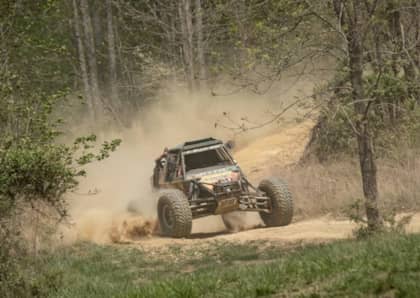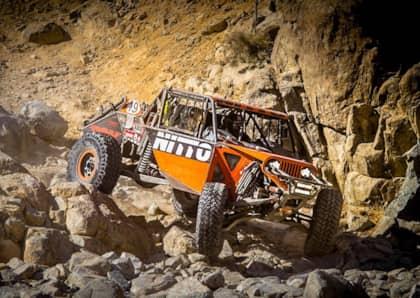Portals To Another Dimension: How Gear Reduction Hubs Are Revolutionizing Off-Road Racing
For years a debate has been raging in Ultra4 racing over whether a solid axle or independent front suspension (IFS) is better. That was the past, the future is in portals. A portal hub can be applied to either a solid axle or IFS, and in either case creates an offset between the axle shaft and the hub mounting surface through the use of a geared hub. The immediate benefit is increased ground clearance, but that is not the only advantage for those looking for an edge over the competition. From rock crawlers to trophy trucks, and now increasingly in purpose-built Ultra4 racing vehicles and more, portals are engineered to revolutionize off-road.

Portals In Rockcrawling
In the rockcrawling world, most builders that have adopted portal axles are motivated by the ground clearance. Packaging portal boxes onto an existing vehicle was always a challenge due to concerns like oil pan clearance and suspension geometry. Early adopters retrofitted the entire axle assemblies out of Mercedes Unimog and Volvo C303 vehicles, but these came with drum brakes, an oddball bolt pattern and a huge differential that was nearly centered in the housing. More recently, Jesse Haines Fabrication has been building axle assemblies that use fabricated Ford 9-inch or Toyota 8-inch housings and third members with government surplus portal boxes from Hummers and lightweight brake assemblies. “By providing a 1.92:1 gear reduction out at the housing ends, all of the upstream components can be smaller and lighter,” Haines explained. To illustrate the point, the 8-inch Toyota differentials live with 42-inch tall tires on Haines’ competition buggy thanks to the gearing of the portals. Custom housings with flipped differentials are necessary since the two-gear Hummer portals reverse the direction of power provided to them. Just bolting them on to a traditional axle would cause the vehicle to go backwards instead of forwards.

Portals In Desert Racing
All-wheel-drive is making a resurgence in desert racing, with builder Mason Motorsports leading the way with their billet aluminum portal hubs. Ground clearance isn’t necessarily the goal in the desert, but rather optimized suspension geometry and wheel travel. Those portals enable the truck’s front suspension to have 24.5 inches of wheel travel, “only about an inch less than our two-wheel-drive trucks,” Neal Mason revealed. “By offsetting the CV vertically, we can get it close to traditional 2WD numbers for bump and droop.” Piloting an AWD Mason truck, Bryce Menzies won the Toyo Desert Challenge at King of the Hammers in 2021, proving this is a winning combination.

Mason manufacturers their own portal hubs, and there are many distinctions from the Hummer portals used in rockcrawling. The Mason hubs are lightweight aluminum instead of cast iron, and they use four gears instead of two. The two idler gears increase strength and rigidity and also allow the torque output to be the same direction as the input. Still, there are plenty of similarities. “Since we’re doing some of the gear reduction out at the wheel,” Mason explained, “The CVs and axles see about 40% less torque than in a standard configuration.” In an effort to provide their customers with a competitive advantage, Mason does not sell their portal hubs individually, but only as part of their unlimited AWD truck package.

Portals In The Every Man Challenge 4600 Class
When Ford decided to throw their hat in the ring in the 4600 Stock Class there were no half measures, they went all in. The manufacturer will be campaigning three identically outfitted Broncos in the 2022 4WP Every Man Challenge. And they will have some of the biggest names in the sport behind the wheels, including Vaughn Gittin Jr, Loren Healy and Bailey Cole. These vehicles began as Sasquatch Edition Broncos but were upgraded by Geiser Brothers with aftermarket suspension and axle components including… you guessed it, portal axles. Since the class only allows a maximum of a 35-inch tall tire, the ground clearance offered by portals is a big benefit in the notorious rock trails of Johnson Valley. Geiser fitted 74Weld portals on the front of the Broncos to leverage the advantages both in the desert and in the rocks found at King of the Hammers. In the rear, a traditional Dana 60 solid axle from Dynatrac was used with a gear ratio that matches the combined gear ratio of the front axle and the 1.45:1 front hubs.

74Weld offers billet aluminum portal boxes that use a four-gear design providing increased strength compared to traditional two-gear portals, and they are available to the general public as well. The 74Weld portal boxes are also the first to integrate a unit bearing, an approach that company founder Quinn Pultz has since patented. “Unit bearings are already common in the Ultra4 world because they are easy to service and do an excellent job with thrust loads,” he noted. 74Weld is also working on bringing portal hubs to the masses, with applications for Jeep Wrangler JKs, JLs, and JTs available on the lakebed at King of the Hammers 2022. Other applications, such as Ford Broncos and Raptors, are also in the works. “The torque multiplication out at the hubs is an under appreciated benefit,” Pultz explained. “These hubs have a 1.19:1 gear ratio, so you can effectively run a 20% larger tire with no additional strain on the drivertrain. That is the equivalent of going from a 33-inch to a 37-inch tall tire without having to add bigger axles or lower gears in the differential.”

This won’t be the first-time portal axles are run in the 4600 class. Despite strict rules regulating wheelbase, suspension design and sheetmetal, the axles have always been fair game for upgrades. In 2020, Jesse Haines piloted a Roxor fitted with his portal axles to victory in the 4600 Class at the Every Man Challenge. “The packaging with portals limited uptravel,” Haines confessed, “but the ability to carry speed through the rocks more than made up for this compromise.”
Portals In The Unlimited 4400 Class
Racers in the unlimited 4400 class recognize the benefits of portal hubs as well. Cody Waggoner and Jordan Pellegrino were early adopters of portal hubs, running two-gear portal boxes from 74Weld on their fully independent Ultra4 cars. Thus far, neither has been able to convert that advantage a victory at King of the Hammers. In fact, a portal-axle equipped vehicle hasn’t won the 4400 Class at the Nitto King of the Hammers since John Reynolds did it back in 2007 at the very first KOH. This year, Loren Healy is hoping to change that though with his new fully independent Ford Bronco buggy.

Built by Triton Engineering and featuring 74Weld portals at each corner with a 1.63:1 gear reduction, Healy commissioned this buggy build with the specific intent of winning King of the Hammers. “Driveline issues have plagued me for the last two years when I was winning the race,” Healy revealed, “and by running independent suspension I can have a skidplate that runs the entire length of the vehicle.” If you think that this sounds like a scaled up UTV, you are not wrong. “Look at how fast the UTVs have gotten at King of the Hammers,” Healy noted. “Last year one finished 11th in the 4400 class, they clearly have a formula for success. You have to drive them differently than a traditional car, but this is basically a scaled-up UTV with 780 horsepower.” The new Bronco buggy is a two-seat chassis with the 460 cubic inch Jeff Ginter-built Ford small block fitted behind the cockpit.

Healy and his Fun Haver teammate Vaughn Gittin Jr. have already been running 74Weld portal boxes on the front of their current Bronco buggies, built by Triton Engineering with IFS and traditional solid rear axles. Gittin is fresh off winning the 2021 Ultra4 Championship and doesn’t plan to merely watch Healy from the sidelines. Expect to see these two portal-axle shod Broncos battling it out for the victory on race day. And if the “win on Sunday, sell on Monday” mantra holds true, we don’t expect to hear much about IFS or a solid axle in the future. Instead, expect to see a whole lot more portals in the Ultra4 field for the 2022 season and beyond.












